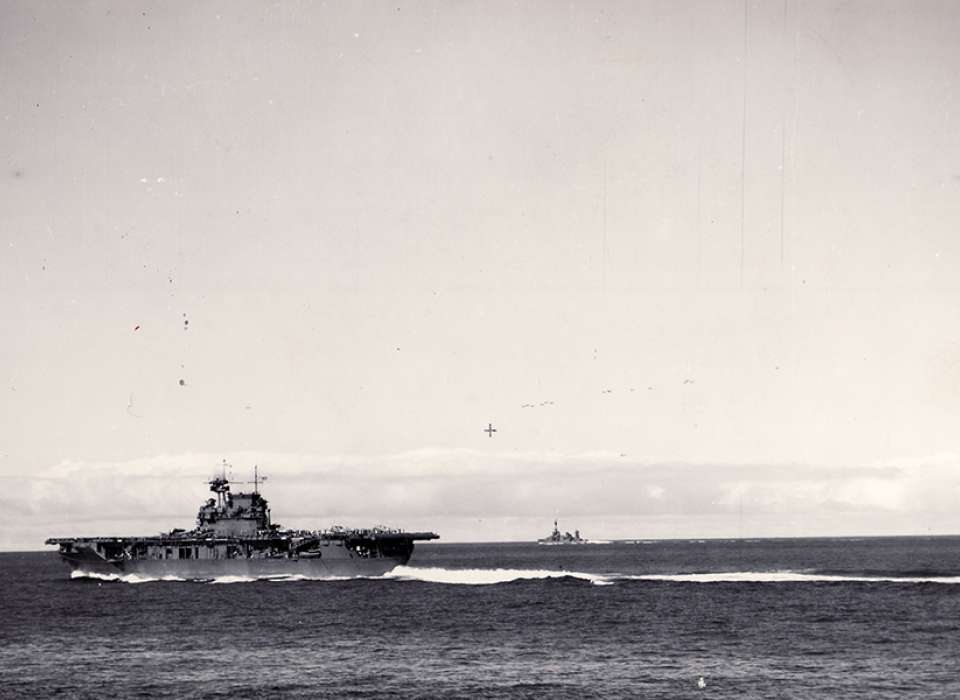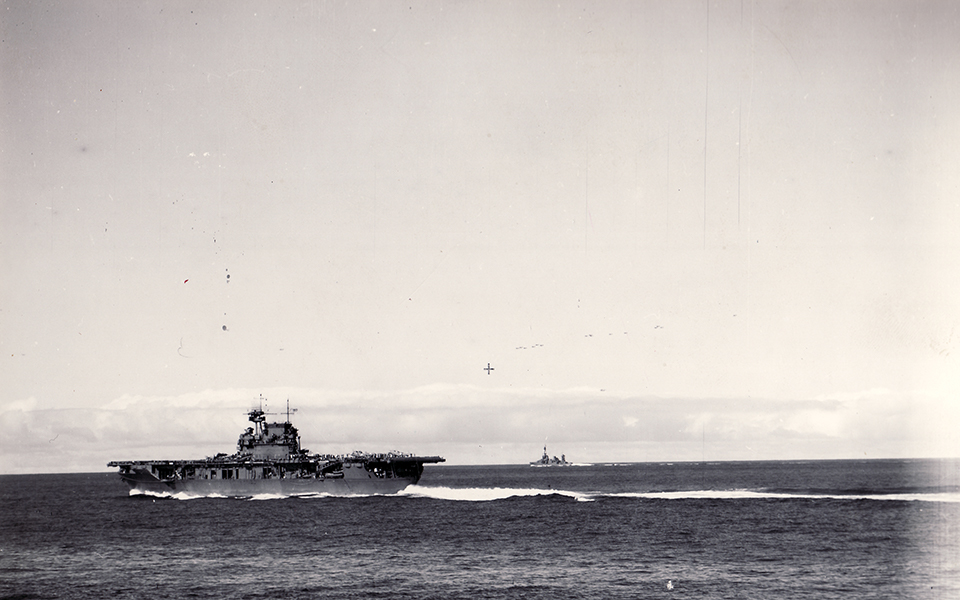Midway, the seminal victory in the history of the United States Navy. It’s a subject that I have studied intensely since I was a young boy. As a result, I have come to know, shall we say, a “good bit” about the battle, especially the US side of it. I got intimately involved in the story. Having personally interviewed over 35 combat veterans of the battle from all squadrons, especially the Enterprise Air Group, will do that to you.
My fascination with the event started after I saw the 1976 film “Midway” with my father on TV at the ripe age of nine. I remember it well; the exploding models of Japanese carriers, footage of diving US warplanes, aircraft carriers at sea, and actors portraying guys named Wade McClusky, Lem Massey, Max Leslie, and many more.
It wasn’t until I started diving into the real history of the actual event, however, that I realized just how poor that 1976 version really was. The details aren’t there, the gist of the story is there, but the portrayals and accuracy just aren’t. So, as a result of the poor original version, when I saw the early advertisements for Roland Emmerich’s new version (which is NOT a remake of the original by the way) I didn’t have very high hopes and had resolved to see it on TV. As fellow historians saw the film I started to see the reviews come out. Some good, some bad. As a result, I decided that I had to see this thing for myself. So I did, with my ten year old son in tow.
Following a very brief setup regarding Japanese and US relations pre-Pearl Harbor, the very next scene is a glorious CGI sweeping pan of the bow of USS Enterprise (CV-6) at sea in all her pre-war glory. The camera sweeps across the “Big E” and shows SBDs and TBDs spotted on her flight deck in correct 1941 colors, while the big carrier is surrounded by her accurate December 1941 screen of heavy cruisers and destroyers. A promising visual start to be sure.
Overall, the visuals in “Midway” (2019) are good. Really good to be honest. Is there too much anti-aircraft fire in the Pearl Harbor attack scene? Yes. Are there too many tracers in the morning attack on “Kido Butai"? Yes. But take that away, and what you see, unless you have a DeLorean and a flux capacitor, are scenes that no one today could possibly ever view again. A full squadron of SBDs in formation at altitude, TBDs skimming low over the water to make their gallant attack on the Japanese carriers, SBDs screaming down on their unsuspecting prey, Kaga, Akagi, Soryu and Hiryu burning and exploding; it’s all there. And it looks good.
Despite their beauty, the visuals, which clearly cost a lot of money, are not the meat of the film. It’s the story and the characters within. And to be honest, the story in “Midway” is less about the Battle of Midway and more about Enterprise Air Group from December 1941-June 1942. And I think that if the viewer keeps that in mind, then all will be good. Those expecting to see full coverage of the four day Battle of Midway will leave the theater disappointed.
Admittedly, the rapid fire coverage of events before the battle scenes at Midway can be a bit jarring if you don’t know your history. And if you do know your history, the viewer can be a bit annoyed by some of the gaffes. Enterprise’s morning flight into Pearl Harbor and the following surprise interception by Japanese attackers is covered well, as is the Marshall Islands Raid of February 1, 1942 which is superb. The coverage of the Doolittle Raid, while exciting, is superfluous. It feels kind of thrown in there because the film makers felt like they “had to” and doesn’t add a great deal to the film. The coverage of Coral Sea, well, that’s where the film starts to go off the rails a bit. Astute viewers will note that Yorktown (CV-5) was never dead in the water and listing at Coral Sea, nor was she near Lexington (CV-2) while she was undergoing her trials either. But as I said, throw that out and keep watching.
When the Battle of Midway actually comes into play, it is done pretty well, lots of detail. Students of the event will recognize Hollywood director John Ford on the island before the battle and during the Japanese air raid on June 4. Being a huge John Ford fan, I especially dug that part. Enterprise Air Group’s flight on the morning of June 4 is done very well. Wade McClusky’s famous decision to keep searching for “Kido Butai” is shown accurately and given its proper prominence. The attack scenes are very well done, and overall pretty accurate. The flight back to the “Big E”, both morning and evening flights, are accurate in their depictions of guys running out of fuel, being shot up by Zeros, and some being captured by the Japanese after ditching. It’s well done.
If I have any real gripes with the film, it’s in the portrayal of characters, (really just one) who are all based on real people. The star of the film is one Richard Halsey Best. Better known as Dick Best, future skipper of Bombing Squadron Six (VB-6) and two hit carrier killer of Midway. In reality, Dick Best was one of the finest pilots to ever grab the stick of an SBD. A Naval Academy graduate (Class of 1932), Best was the consummate professional Naval Aviator, master of his craft and a true leader. In the film, he is portrayed as a mouthy cowboy. A 1942 version of Maverick, he takes unnecessary risks and mouths off to his superior officers. While the movie shows him to be brave and heroic, and he was, it does a disservice to the actual man by showing him to be the opposite of what he really was, which was an officer and a gentleman.
Other characters pertinent to the Midway story are shown, like intel officers Edwin Layton and Joe Rochefort. And while Rochefort is still shown to be wearing his robe and slippers, he is thankfully NOT portrayed as the eccentric looney that Hal Holbrook graced us with in 1976. The real characters are all there, and Dick Best (and to a point Wade McClusky) is done fairly well and accurately.
Throwing the character gaffes and the handful of historical miscues aside, however, will still leave the viewer with an entertaining film. And as a friend of mine and fellow Naval historian told me this morning, “if a movie entertains me, then it’s a good one." And “Midway” certainly does that. Is it perfect? Of course not. No movie is. Is it 100% accurate to the history of Enterprise Air Group in the early part of the war? Nope. Is it close? Close enough. Is it a 2 hour and 20 minute documentary on the Pacific War? No it is not. What it is, is an entertaining film that leaves the viewer wanting to know more about the actual people portrayed and the actual events that transpired. As I walked out of the theater with my son, I asked him if he liked it. He said he did and when he closed the door of my truck, asked me, “Did all those things really happen?” When I answered in the affirmative, he asked again, “Can you tell me about some of them?” Mission accomplished.
Seth Paridon
Seth Paridon was a staff historian at The National WWII Museum from 2005 to 2020. He began his career conducting oral histories and research for HBO’s miniseries The Pacific and holds the distinction of being the first historian hired by the Museum’s Research Department. In the 12 years he was Manager of Research Services, Seth and his team increased the oral history collection from 25 to nearly 5,000 oral histories.
Cite this article:
MLA Citation:
APA Citation:
Chicago Style Citation:










